Johanson Dielectrics PN 500T15W103MV4E MLCCs
Gideon Analytical Laboratories received two printed circuit board (PCB) assemblies, each of which had a single multilayer ceramic capacitor (MLCC) suspected of failing. These MLCCs are Johanson Dielectrics PN 500T15W103MV4E. A PCB mechanically supports and electrically connects electronic components using conductive tracks, pads and other features etched from copper sheets laminated onto a non-conductive substrate. Components (e.g. capacitors, resistors or active devices) are generally soldered on the PCB. Advanced PCBs may contain components embedded in the substrate. Multilayer ceramic capacitors are fixed value capacitors in which ceramic the material acting as the dielectric. It is made up of two or more alternating layers of ceramic and a metal layer acting as the electrodes. There are various types of materials that could function as the dielectric in a capacitor. The goal was to determine the cause of the Johanson Dielectrics PN 500T15W103MV4E MLCCs failure.
With routine efficiency and expertise, Gideon Analytical Laboratories began failure analysis. First, the MLCCs were tested for porosity and adhesion of the silicone to the solder mask. They were then electrically tested. There are two MLCCs; C2 and C3. The results are below:
| MLCC | As received | Trace lines cut | Bake 125C 1hr | Contamination | No coating and clean |
|---|---|---|---|---|---|
| C2 | 555 ohms | 556 ohms | >1G | no | 62Kohms |
| C3 | 1.652K ohms | .760K ohms | 3K ohms | no | 2.0K ohms |
The Johanson Dielectrics PN 500T15W103MV4E MLCCs were then prepared for cross section and inspected externally for cracks. There was no contamination between the terminals. There was no external cracking. During the cross-sectioning, we noticed several cracks. More importantly, the electrode spacing on the top is different than the electrode spacing on the bottom. This is important because the dielectric material is the same and the spacing determines the voltage rating. Having been doing electronic failure analysis for decades, this is the first time we had ever seen electrode spacing like this. When the MLCC was electrically tested in this cross-section, the result was a dead short. Unfortunately, bothJohanson Dielectrics PN 500T15W103MV4E had cracking and abnormal electrode spacing. These problems are manufacturing issues.
With pride and precision, Gideon Analytical Laboratories once again rose to the occasion. Electronic failures happen. Let us help you deal with them. Let Gideon Analytical Laboratories give you the peace of mind that comes with having products that are reliable. Save time and money. We cure headaches better than Advil and a temple massage. Do you need help? Let us help you. If you are having electronics failures, call Gideon Analytical Laboratories today.
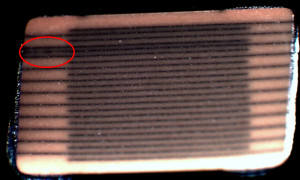
MLCC with abnormal electrode spacing shorts out
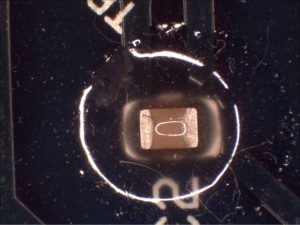
C2 MLCC
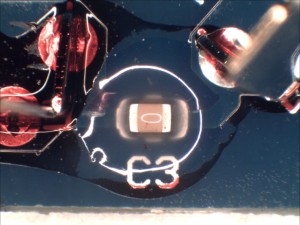
C3 MLCC
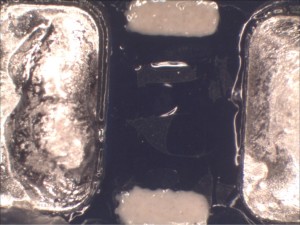
C3 dye test
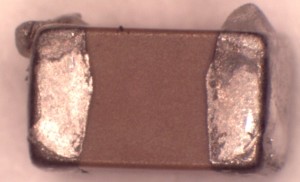
C2 no cracks
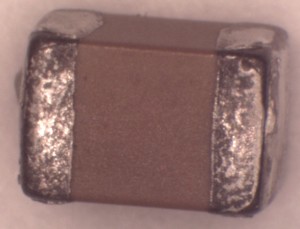
C3 no cracks
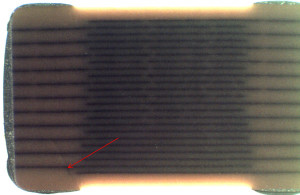
C2 crack
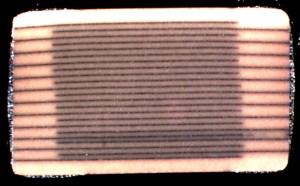
C2 abnormal electrode spacing
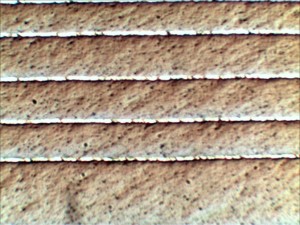
Different electrode spacing on top than bottom. Top
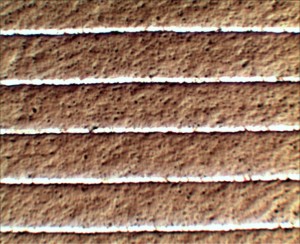
Different electrode spacing on top than bottom BOTTOM